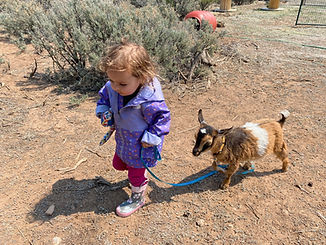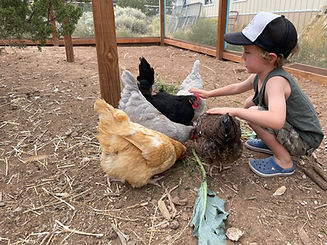
OUR MISSION
Build upon the natural rhythms of child-led play to allow all children the opportunity to grow as resilient global citizens capable of developing their own interests, working cooperatively, feeling compassion, taking risks, and connecting to the natural world.
Guiding
Philosophy
Worms and Wildflowers Nature School believes it is the right of every child to have ample outdoor playtime and it is essential for healthy childhood development. We understand that sustained child-led play in nature allows for the opportunity to engage in truly meaningful learning and to build natural connections with the local environment.
The role of educators in our nature programs are to help facilitate the process of children identifying their own interest, questions, and ideas. Through the introduction of engaging materials, unique interactions with peers, and the natural world, student’s interests will be celebrated and used to guide future activities and learning moments.
We are a state licensed facility and value our connections with the early childhood and outdoor community.
Our Curriculum
Emergent curriculum, flowing from children’s interests and personal relationships. The natural cycle of the seasons guide the daily activities of Worms and Wildflowers students. With comparable attributes to the whole child approach of Reggio Emilia, we will address the cognitive, physical, and social-emotional development of every child through play-based hands-on outdoor activities. Foundational skills such as, critical thinking, creativity, curiosity, and problem-solving are prioritized in our curriculum. These foundational skills all inform a child’s ability to learn, retain, and use academic skills in their future. (Rymanowicz, Hetherington, Larm, 2020)
Seasonal play will be enhanced with selected activities from Cultivating Joy and Wonder, Written By Emily Hoyler and Linda Wellings. You can access and download this supplemental curriculum on Shelburne Farms Website www. store.shelburnefarms.org/product/cultivating-joy/education_resources
Core activities will include:
-
Celebrating seasonal change through exploring, art, observation, harvesting, experimentation, and off-site hikes to local natural spaces.
-
Cooperative play including fort building, loose parts, mud kitchen play, and STEM challenges.
-
Children’s garden play, where students can dig in the dirt, search for soil life, plant, harvest, and cook edible plants while learning about plant life cycles, nutrition, and soil science.
-
Live animal care to foster interpersonal communications skills and empathy for a diversity of life. Daily opportunities to engage with animals on site include visiting our chickens, goats, tortoise, and snake.
As a nature school, most of the day will be spent outdoors. We will sustain the well-documented benefits nature provides to the mental well-being of children. This includes a restorative effect from stress and an improved sense of well-being, as well as reduced social, emotional, and behavioral difficulties. (Barrable, 2019, Omidvar, Wright, & Beazley, 2019) Continued outdoor and farm-based play allows individual children to develop a comfort with the natural world and the life-sustaining elements within. Time spent connecting to the natural world and our place within it has been linked to increased environmental literacy, affinity for nature, a sense of ownership, and the desire to care for the local environment. (Sobel, 2013) Our daily routines foster the many benefits outdoor education provides and include outdoor child-led play, garden caretaking, animal care, and wild exploration.
Worms and Wildflowers Nature School strives to educate the whole child while also incorporating place-based education. Place-based education provides learning opportunities that connect with history, culture, social problems, and the environment. A child is an active participant in place-based education where their own contributions to the larger community and environment is highlighted.
Students will spend most of their day outside. Outside time, along with a Reggio Emilia inspired curriculum, will allow children to experience a deep and personal connection with the outdoors, their own learning, and the community. On any given day you may see children taking self-calculated risks, including digging in the mud, jumping in puddles, climbing in trees, creating with sticks, or petting goats! The daily schedule will:
-
Allow time for unstructured, child-directed play in the local ecosystem.
-
Allow for periods of inquiry and reflection to strengthen personal connections to the environment, our classroom community, and curriculum themes we have been exploring.
-
Provide opportunities for children to work cooperatively together, problem solve, take self-calculated risks, and build social confidence.
-
Build physical endurance as well as fine and gross motor skills though hiking, building, and creating.

What is Reggio Emilia Inspired Curriculum?
Reggio Emilia is an approach to early childhood learning named after the town where it originated in Italy. Founder Loris Malaguzzi believed children were in need of a more holistic kind of education after World War II. He began the Reggio Emilia style based on the belief that every child is unique and will express their interests in many different ways. Educators learn with the child and community in a co-learning environment.
Reggio Emilia also revolves around the children’s senses, relying on sight, sound, touch, taste, and smell to assist with learning. As a result, Reggio Emilia classrooms tend to look different than your average preschool with large common spaces, natural elements and lots of accessible and curiosity-sparking materials. Emergent curriculum, in-depth projects, representational development (dance, paint, wire, clay, pencil, nature materials...students can represent growth and learning in many different ways) and collaboration are common in Regio Emilia classrooms.
What is Risky Play?
Risk presents the child with a challenge where the outcome is uncertain, and the child chooses whether or not to take it. An appropriate risk allows for children to approach the challenge, take it in, and then grow in motivation, creativity, and self-confidence. (Gladstone and Rice, 2017)
-
Like other mammals, humans need to take calculated risks, in the form of play, in order to better understand their own potential and place in the world. (Gray, 2018)
-
Risky play where children are in control of calculating an appropriate risk is central to Worms and Wildflowers's philosophy. The outdoor environment provides a plethora of opportunities for risky play including, jumping from rocks, balancing on log “bridges”, swinging from branches, animal role-play, hide-and-seek, building forts, and exposure to our class campfire.
Benefits of Risky Play:
-
Hypothesize
-
Make judgments
-
Make decisions
-
Evaluate outcomes
-
Develop new strategies with unexpected outcomes
-
Repetition to mastery – determination
-
Provides boundaries
-
Tests limits
-
Overcome fear
-
Control emotions
-
Build resilience
-
Develop independence and confidence
-
Ability to make decisions to keep themselves safe
“If we want our children to move mountains, we first have to
let them get out of their chairs.”



How do Animals Benefit Children?
Daily animal interactions help children:
-
Gain confidence
-
Increase connections to the world separate from themselves
-
Strengthen observation and interpretation skills
-
Understand cause and effect
-
Improve social, cognitive, and interpersonal skills
Live animal interaction and care is an exciting part of the day for students. Our resident animals are fun to visit with but also serve a greater purpose. “When children practice caring for animals, they learn social and cognitive skills that increase their connection to the world outside themselves.” (Selly, 2014) Patty Born Selly describes the three elements of caregiving that can be experienced through regular interaction with an animal in her book Connecting Animals and Children. These include being aware of another’s need, putting another’s need first, and finally acknowledgment by the recipient of care. For a child this can be as simple as hearing a goat’s repeated bleating, interpreting that sound to know the goat is hungry, stopping what they are doing to feed the goat, and then finally watching the goat eat. This interaction allows the child to gain confidence in their own ability to care for another being.
Research has shown that early experiences of caring for animals can grow into feelings of stewardship for the natural world. (Selly, 2014) At Worms and Wildflowers Nature School daily animal interactions will help children gain confidence and reinforce their own ability to care for other beings. The relationships developed with our resident animals create space for children to explore and develop interpersonal skills that will influence other areas of their lives, including their relationships with peers. Caring for animals helps children explore their own power, strengthens their skills of observing and interpreting, and allows for growth in their own ability to care for others and the natural world.
Barrable, Alexia. “The Case for Nature Connectedness as a District Goal of Early Childhood Education”. International Journal of Early Childhood Education, 6(2), P. 56, 2019.
Gladstone, Rice. We’re OK with Risky Play. Lawrence Educational, 2017
Gray, Peter. Free to Learn. Blackstone Publishing. 2018.
Omidvar, Wright, Beazley. “Investigating Nature-Related Routines and Preschool Children’s Affinity to Nature at Halifaz Children’s Center”. International Journal of Early Childhood Education, 6(2), P. 42, 2019.
Rymanowicz, Hetherington, Larm. “Planting the Seeds for Nature-Based Learning: Impacts of a Farm-and Nature-Based Early Childhood Education Program”. International Journal of Early Childhood Environmental Education. 8(1), P. 44, 2020.
Selly, Patty Born. Connecting Animals and Children. Red Leaf Press, p.30. 2014.
Sobel, David. “Place-based Education: Connecting Classrooms and Communities”. The Orion Society, 2013.